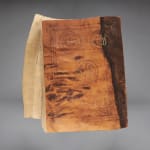Mughal Monumental Illuminated Qur'an, c. 1700 to 1900 CE
Ink and paint on paper. Bound in leather
113 x 81 cm
44 1/2 x 31 7/8 in
dimensions given for single leaf or closed book
44 1/2 x 31 7/8 in
dimensions given for single leaf or closed book
LI.3509
Further images
-
(View a larger image of thumbnail 1
)

-
(View a larger image of thumbnail 2
)

-
(View a larger image of thumbnail 3
)

-
(View a larger image of thumbnail 4
)

-
(View a larger image of thumbnail 5
)

-
(View a larger image of thumbnail 6
)

-
(View a larger image of thumbnail 7
)

-
(View a larger image of thumbnail 8
)

-
(View a larger image of thumbnail 9
)

-
(View a larger image of thumbnail 10
)

-
(View a larger image of thumbnail 11
)

-
(View a larger image of thumbnail 12
)

-
(View a larger image of thumbnail 13
)

-
(View a larger image of thumbnail 14
)

-
(View a larger image of thumbnail 15
)

-
(View a larger image of thumbnail 16
)

-
(View a larger image of thumbnail 17
)

-
(View a larger image of thumbnail 18
)

-
(View a larger image of thumbnail 19
)

-
(View a larger image of thumbnail 20
)

-
(View a larger image of thumbnail 21
)

-
(View a larger image of thumbnail 22
)

Calligraphy has never been challenged as the supreme art of the Islamic world, reflecting the centrality of the Quranic revelation to Islamic faith and culture. In Islam, the Qur’an is...
Calligraphy has never been challenged as the supreme art of the Islamic world, reflecting the centrality of the Quranic revelation to Islamic faith and culture. In Islam, the Qur’an is held to be God’s actual revelation. The establishment of the “Abbasid Caliphate (750-1258), with its capital in Baghdad, marked a new stage in the cultural and economic integration of the Mediterranean and Asia. Among the new cultural forms that emerged in the cosmopolitan early ‘Abbasid period were illuminated Qurans in horizontal format, written in angular scripts frequently called “Kufic”, after the city of Kufa in Iraq; where the style is said to have originated. The crisp elegance of many of these scripts and the luxurious sophistication of illumination in the first centuries of the ‘Abbasid period have contributed to the notion that this was a “classical” age in the Quran production, resulting in this style being echoed through the history of the production of Islamic manuscripts.
This is monumental Quran manuscript dating to the Mughal period written in the Kufic script in brown/black ink on cream-coloured paper. There are also two illuminated frontispiece in colours and gold and the start and end of the Quran. Original binding in brown leather, with flap and decoration.
This majestic manuscript would have most probably been commissioned as a gift for the highest Mughal elites, revealing the extraordinary cultural refinement and advancement of the Mughal Empire.
The Mughal Dynasty was a line of Muslim emperors who ruled over lands comprising the modern states of India, Pakistan, and Afghanistan. The Mughal style blended the native Persian patterns imported by the Mughals with the indigenous genius for intricate craftsmanship that characterizes the subcontinent. Noted equally for their distinctive architecture as well as their beautiful jewelry, the crowning achievement of this style is the Taj Mahal, the world famous monument built in the Mughal capital of Agra.
This is monumental Quran manuscript dating to the Mughal period written in the Kufic script in brown/black ink on cream-coloured paper. There are also two illuminated frontispiece in colours and gold and the start and end of the Quran. Original binding in brown leather, with flap and decoration.
This majestic manuscript would have most probably been commissioned as a gift for the highest Mughal elites, revealing the extraordinary cultural refinement and advancement of the Mughal Empire.
The Mughal Dynasty was a line of Muslim emperors who ruled over lands comprising the modern states of India, Pakistan, and Afghanistan. The Mughal style blended the native Persian patterns imported by the Mughals with the indigenous genius for intricate craftsmanship that characterizes the subcontinent. Noted equally for their distinctive architecture as well as their beautiful jewelry, the crowning achievement of this style is the Taj Mahal, the world famous monument built in the Mughal capital of Agra.





















